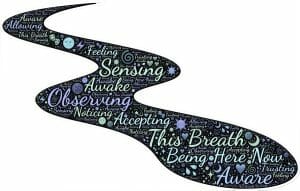Mindfulness is a journey, something you’ll always work on. Even the Dalai Lama and Desmond Tutu work on their mindfulness daily! Mindfulness, in my way of thinking, is being present, aware, alert, intentional. One person I talked to about mindfulness said she feels calmness when she’s mindful.
 If you are new to the LIFE site, or want a refresher on the subject from my perspective, here are previous articles or Live Streams on the subject of mindfulness:
If you are new to the LIFE site, or want a refresher on the subject from my perspective, here are previous articles or Live Streams on the subject of mindfulness:
Empowering Yourself Through Mindful Balance
Mindfulness: Moment By Moment
Mindfulness: 3×2 Framework
Mindfulness: Presence Thieves
How do you know when you are being mindful? My senses are more alert in that I can hear, smell, see, taste, and sense more things — and all at once; I feel present, productive, powerful; and I feel centered and grounded. With all that going for me you’d think I’d stay mindful more often. Yeah, me too.
Mindfulness is a muscle to be worked, just as you do all your other muscles. The difference is that you can’t see it, as you can most of your other muscles. What helps you stay mindful? It’s a tough question to answer, isn’t it?
Here are things people do to stay mindful. Let’s see how these ideas help you.
Setting the intention to exercise your mindfulness muscle is the first step you must take before any of the other suggestions will make a difference. Do you know why you want to be mindful? I have answers for that, but…. I’m not living your life. </news alert> You need to have your own answers. Feel free to contact me if you want pointers on why mindfulness will benefit you.
State that intention. State it daily to yourself. State it frequently to others.
Meditation is an easy and valuable way to build your mindfulness muscle. Partially because you get to practice mindfulness as you meditate to keep you centered and present. You get to practice, practice, and practice some more. It gets easier every time you meditate. Remember to be kind and gentle with yourself when you find your mind wandering. When you become aware that your mind has wandered, gently bring it back to focus (I like focusing on my breath and the top of my head; you may have other ideas, so follow whatever works for you).
Reminders work too. You could set phone alerts throughout the day, either in your phone calendar or in an app. Or be old-fashioned and use sticky notes posted around the home and office, even in the car. A more subtle reminder would be the use of a totem or medallion, like a pendant, that you can place on your key chain, neck chain, tuck into your pocket, or even tie it to a ribbon and use it as a bookmark — if you read paper books. One client of mine uses a rubber band on her wrist that she snaps when she realizes she’s missing her mindfulness.
When I became serious – really and truly serious — about quitting sugar for good I connected with a woman I didn’t even know. We were in the same Facebook Forum with the same desire so connected over our desire to ban sugar from our lives. We felt it would be beneficial to have someone to quit with, someone to support us. She became my Accountability Buddy. We started texting each other daily to report on our sugar-free success. Going sugar-free was one form of mindfulness for me because I had to be ever mindful to not succumb to my brain wanting a sugar hit. Having an Accountability Buddy worked well because we each took the attitude we didn’t want to have to report to the other we’d fallen off the wagon. When we did fall off the wagon, we gently support each other about being kind to ourselves as we dusted ourselves off and climbed right back up on the wagon. Try it, you’ll like it…and it works; I’m sugar-free 90 days, September 17, 2017, being my 3-month anniversary. 🙂 How’s that for a strong mindfulness muscle?
Building routines for yourself is another way to help you exercise that mindfulness muscle. You can attach mindfulness to the various activities you do in your sundry routines. Be attentive as you eat — chewing and swallowing with intention. Be aware while brushing and flossing your teeth. Be conscious while you are with your pets, kids, and partner. Be observant while moving and exercising, be that walking, cardio, CrossFit, swimming, or dancing. With enough practice that mindfulness will flow onto your writing, speaking, and thinking, too.
Mindfulness is a muscle to be exercised frequently. Use it or lose it. Losing it isn’t one of your better options or ideas. Using it is. Flex that muscle and be mindful, making a better life for yourself.
